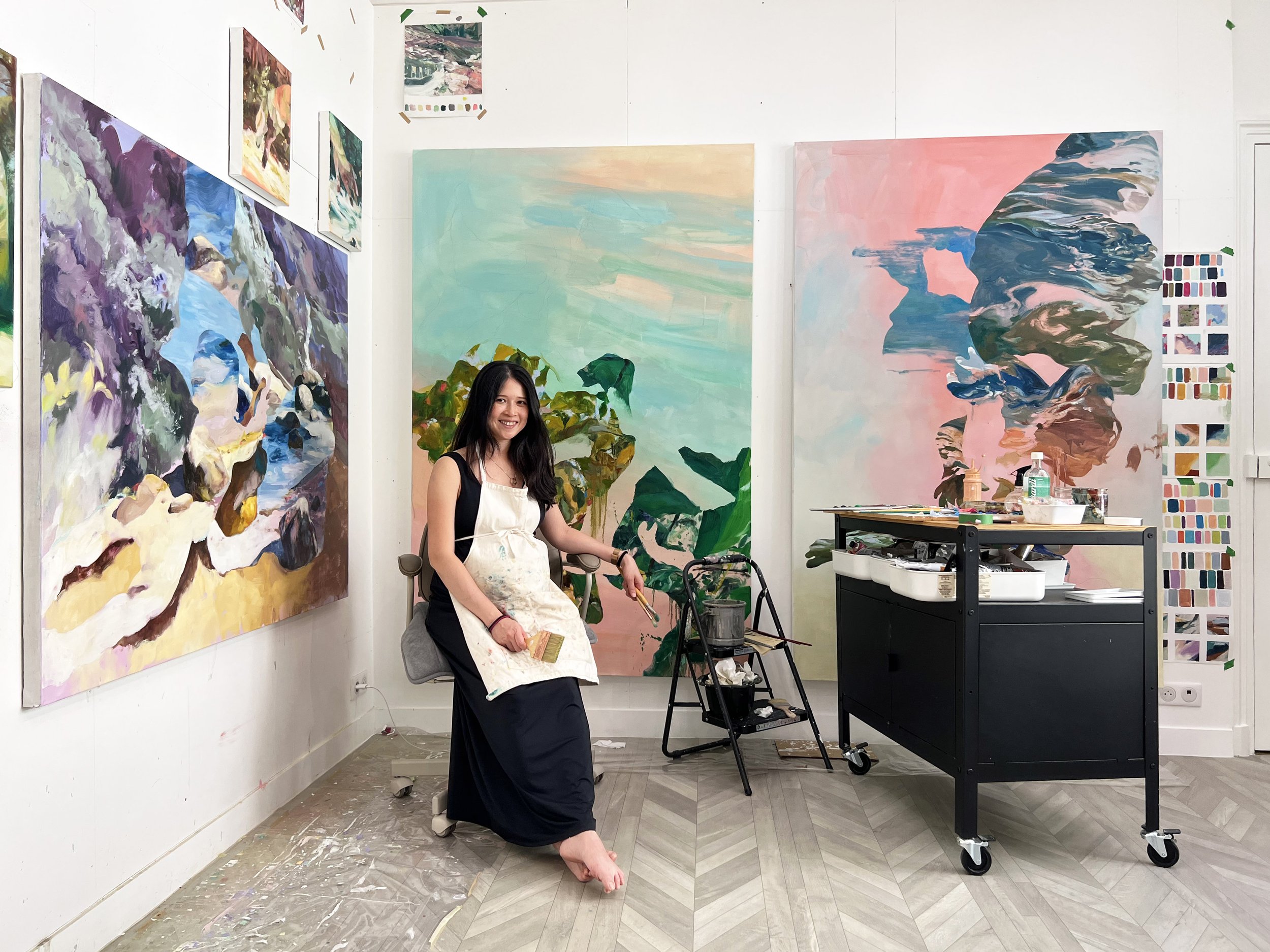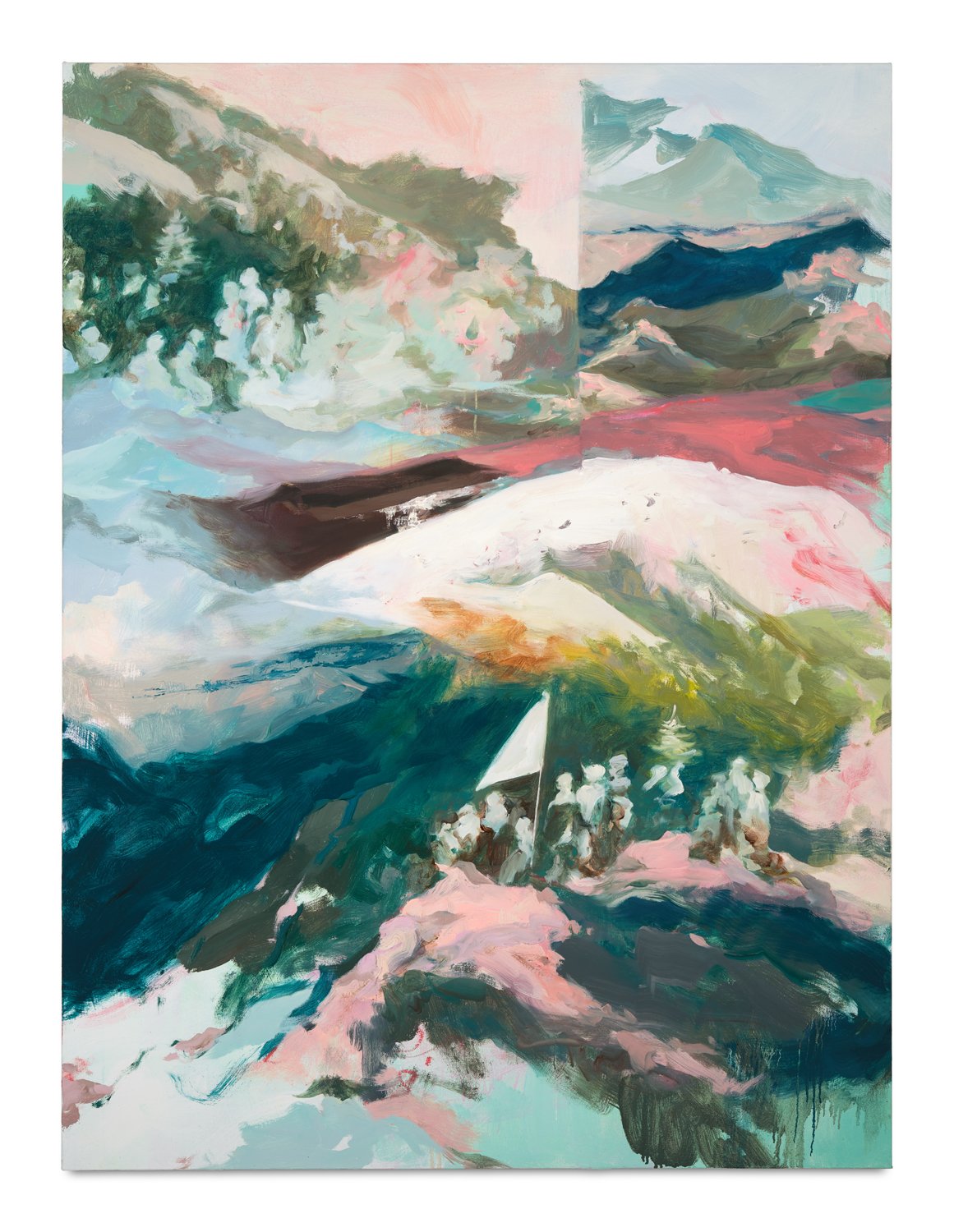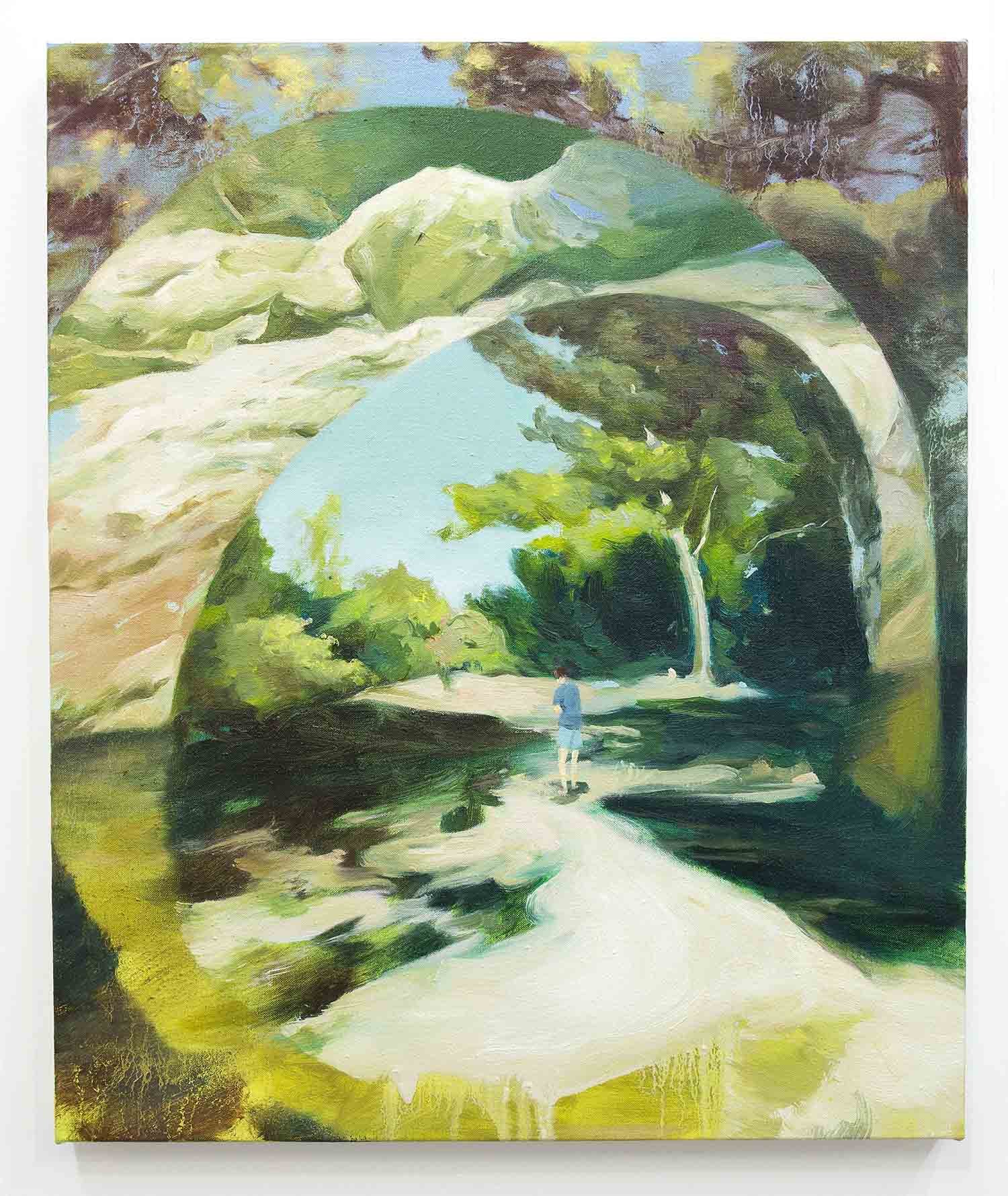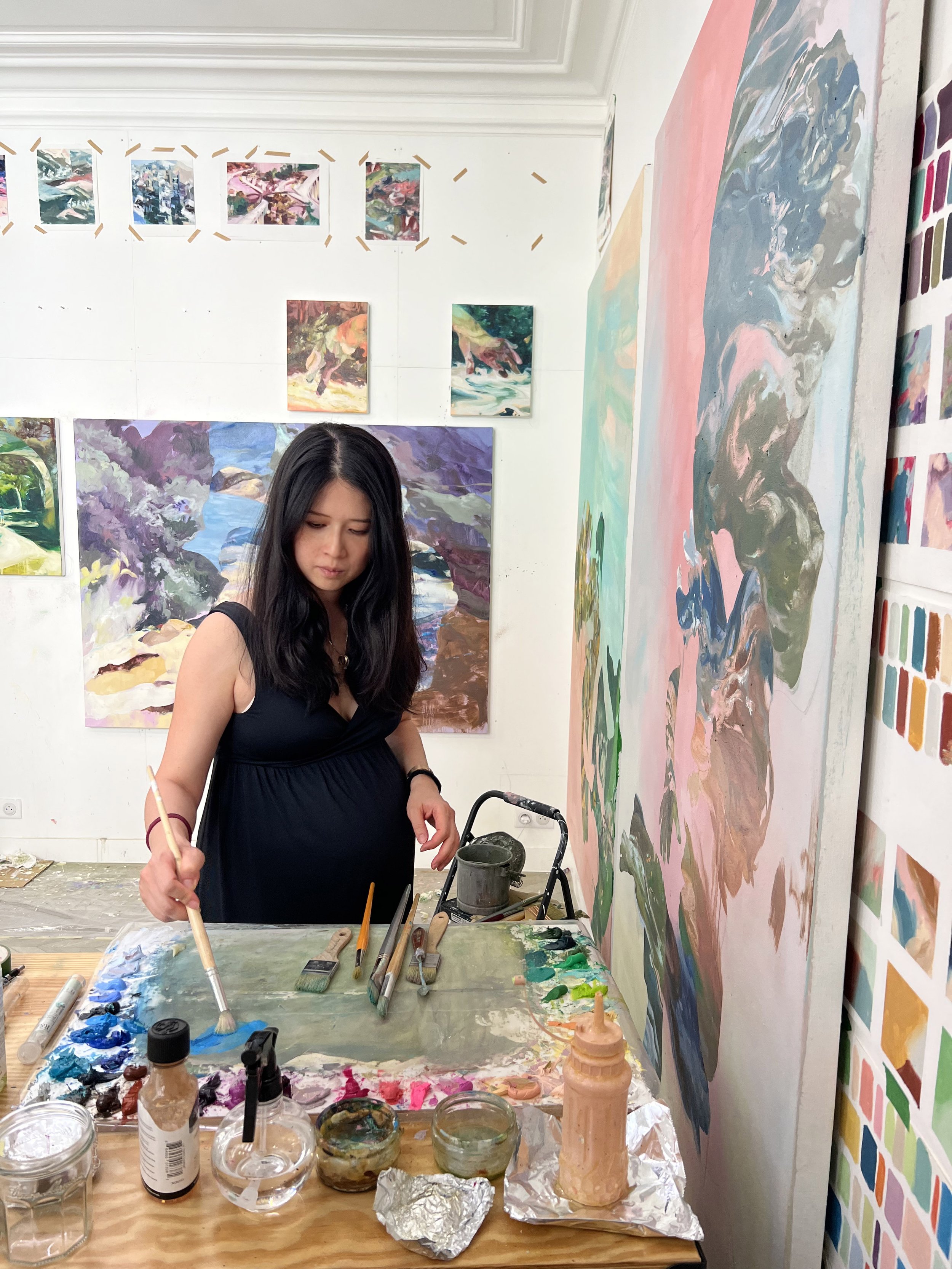Peihang Benoît in her studio photographed by Clara Yu
Photo courtesy of the artist
Damaris Athene: Could you start off by telling me a bit about yourself please Pei?
Peihang Benoît: I'm originally from Taiwan and I spent my childhood in the States. I moved to London for further studies but, before I moved to London, I already had a career in Taiwan and decent gallery representation in Taipei. Yet I always felt like there was much more in the world that I should explore. So I took a chance and restarted in the UK. It feels refreshing, like I've had a second life to restart over. It was extremely exciting to be in London, because all sorts of people live there. After five years in London, I had the opportunity to move to Paris. It's another challenge. It’s not the easiest because there's a language barrier and French culture is very unique. But I feel incredibly lucky to experience three major cultures, American culture, British culture, and now French culture. My roots are in Taiwanese and Chinese culture. I hope it all influences my practice in many ways.
DA: I didn’t know you used to have gallery representation in Taipei. What's the art scene like there, and in Taiwan generally?
PB: There's an East Asian character that's very identical. The activity and market over there could be top 10 in the world or more if you consider the tradition of collecting Chinese antiques and modern masterpieces. It is a lot bigger than we realise. I still think people are very influenced by Japanese culture and aesthetics in terms of contemporary art. Super flat has a big influence for instance, as well as artists such as Nara Yoshimoto and animation. It's getting more and more international, and the new generation is rising. The character of the Taiwanese art scene is moving very fast with technology.
Youth Activities 4, 2019, Oil, oil stick and acrylic on linen, 180cm x 115cm
Photo courtesy of the artist
DA: Fascinating! Could you tell me more about your practice?
PB: My practice is basically about my everyday life. I think it was rooted in me from the very beginning of my practice when I tried to look around my environment. It's a bit like a personal diary — I’m like a mirror to reflect what is happening around me. It's not just about being Taiwanese, you know, it’s also about being a female or being a kind of identity, or a living person in general. At the moment I'm working on something about the experience of confinement. I think it drives men even crazier than women, because I feel like at some point, we're ready to be confined. Taking myself for instance, when I just gave birth to a baby, I knew that I had to stay at home, so the lockdown that happened at the same time was ok. But it became extremely painful for my husband — he felt like he lost his own world and that kind of change and how he reacted to it intrigued me a lot. I tend to switch topics or subjects about every two or three years. My last project ‘Youth Activities” was about my relationship with my mother. She passed away a few years ago. I went to dig into our history — I enjoyed the process of taking myself out of it, and then to review her life and my life as a whole to compare.
DA: Interesting to hear how your ideas change every few years.
PB: It corresponds to different stages of life. My topic is always in flux. I work through things and then move on.
DA: Yeah, it’s evolving as you're evolving yourself. When you come across different obstacles, you can use it as a tool.
PB: It’s like therapy!
Gateway 3, 2022, Oil and acrylic on linen, 60cm x 50cm
Photo courtesy of the artist
DA: Do you work with any other media apart from painting?
PB: I make ceramics. I’ve also made some songs and done some photography, as well as conceptual artwork. When I go on residencies, I like to try something different. I also did some social projects based on painting that were more like a performance. Painting is the main thing and then ceramics is my second love, because it feels like painting in 3D.
DA: How did your painting style develop?
PB: I have had this very strong intuition and this very painterly style from the very beginning. All these years, it’s stayed the same whatever the subject or the method of painting. It’s evolved but it’s still there. It has built my confidence. I have a specific way of touching the paint. From very early on I was shown Impressionist paintings. In Taiwan we have had this strong influence from Japan since being colonised by them. They love Impressionist paintings there because of the Japanese/French connection after the war.
DA: It's fascinating to hear how your style has developed. How do time, space, memory, and the migratory experience feature in your practice?
PB: My practice is all about my everyday life and how I experience it personally. I’m an individual who is influenced by a bigger tidal wave of history. Since I decided to leave Taiwan, I felt like my life has changed a lot. The first thing you have to face is how to place yourself in an entirely different environment. I would say in these four key words, the migratory experience is the most important one. Time and space change because of the change to be in different places and within different cultures. Memory corresponds to time — you always look back to your own past. What has been changed and what has not and what has been left there for you to carry on? All these questions, and the somehow uncomfortable things caused by my personal experience of constantly moving, are things that I want to visualise in my works.
Installation view of Peihang’s solo show ‘All Her Bright Times’, Yiri Arts, Taipai, Taiwan, 2021
Photo courtesy of the artist
DA: Can you take me through your process?
PB: All my works are photography based. I use random phone photos and my memory. I come back to dig into my own archive.
DA: There’s a lot of fragmentation in your paintings. Do you mentally collage the different photographic images in your head, or are you responding to the paint on the canvas?
PB: Well, there are two stages, the pre canvas stage and working on the canvas. I do have a kind of collage method in my mind. With my current project I take interesting contours from my phone archive, using shapes to lead to another world outside. It's about interior and exterior, about now and the future or the past. In your mind you can be in many places at the same time. My process is heavily influenced by the Photoshop process as well and I use it to make a reference image that I then paint onto the canvas. Once I’m painting the texture is very important, you need to respect the material itself. Paint has a lot of potential to be thick and to be thin. I feel a rhythm with oil painting. It's like singing a song. As a result my work is very organic.
DA: Your paintings are so visceral and delicious! I hope I’m able to see them in person one day. The materiality of the paint is so seductive.
PB: It's like having the pastry, you know! The cream on the cake. I love to embrace beautiful colours. The subject could be serious but visually it has to be something that sings along with me.
DA: Yeah! How has the pandemic affected your work?
PB: The pandemic is everything in my work right now. Have we even got over the pandemic yet? There are long term effects. It was important for me to not respond to it immediately in my work because I need the time to reflect and explore things in more depth.
Gateway 2, 2022, Oil and acrylic on linen, 40x30cm
Photo courtesy of the artist
DA: What would you like people to get from your work?
PB: I love people to see part of themselves in my work, everybody has a different history. We're not from the same culture but we're humans. As humans we go through the same thing.
DA: Whose work inspires you?
PB: My all time favourite is Francis Bacon. I like the tremble in his work and I try to do that with my work. I also love Cecily Brown. There are many more women artists who inspire me more than men. Early on, I was so drawn to Jenny Savile. I was quite shocked by her work. I love Marlene Dumas a lot. You feel the flesh in a very thin, washed layer of paint. Thinking about time and space, Julie Mehretu and Sarah Sze are artists who give me a very good sense of addressing directions, finding the map in your mind. They are the artists who inspire me to pursue this direction in my work, not the visual outcome but the process. In terms of younger artists, I like Michael Armitage very much too. It's very painful and has this historical context, but it's also everyday life. I think his work is fantastic. Caroline Walker is someone else I’ve been looking at. There has been a renaissance in painting recently. More and more artists are embracing and celebrating painting in a very painterly way. I quite like Rute Merk and Avery Singer too, their works are about post-image and very interesting.
DA: A great selection, you’ve mentioned so many of my favourite artists. We have very similar tastes!
PB: I also like Jenna Gribbon, and Flora Yukhnovich. A lot of people have said that we have a similar visual language. Her works give you a strong impression. The list goes on and I could mention so many more people!
DA: What projects have you been working on recently? You mentioned the series about confinement earlier.
PB: That will be it actually, at the moment, because I'm pregnant! I will be giving birth to a second daughter in August. I'm trying to finish as much as possible before then. But this pandemic thing will continue because pregnancy is another confinement. I can use it, embrace it further and revisit it.
Youth Activities 1, 2019, Oil, oil stick and acrylic on linen, 180x115cm
Photo courtesy of the artist
DA: Congratulations! How much time will you have to take off painting?
PB: We'll see. My studio is at my home which helps. It works really well for me. During the hours the babies are asleep, I can still do a little bit of this and that.
DA: I hope you're able to carve out some time, although I'm sure it will be difficult at the beginning. Are you having any exhibitions before then? Or are you in wrapping up mode now?
PB: I'm wrapping up and I will have a major solo exhibition next year in Taiwan. I'm really looking forward to that, because it's in a dream gallery where the curator is constantly in touch with me to discuss the development of the work.
DA: Amazing news! I look forward to seeing photos of the exhibition.
PB: I hope to have more capacity for projects in Paris or London as well. I'm developing my knowledge of the art scene in Paris. The two years where everything was shut down and it was just hard to explore all over again from scratch. So that’s why I felt like we were living on an island.
DA: It's a hard time to move to a new place.
PB: It's quite a challenge with not just the language barrier but also the cultural barrier, and then with having a family I’m not as free as I used to be to go out and mingle. But it will come!
DA: Indeed it will! Thank you so much Pei.
PB: Thank you for the questions.
Multiverse 4, 2022, Oil and acrylic on linen, 60x50cm
Photo courtesy of the artist







